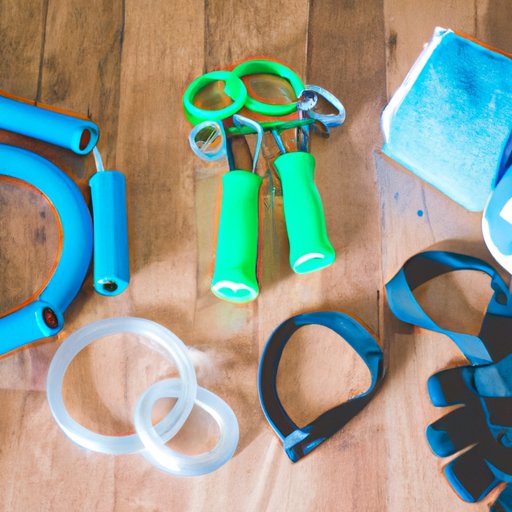
I. Introduction
Weight loss is a common goal for many people, but knowing where to start can be overwhelming. Cardio, or aerobic exercise, is a popular and effective way to burn calories and lose weight. This article will provide a comprehensive guide on how much cardio is needed for weight loss, including different types of cardio, workout frequency and duration, and tips for incorporating cardio into your fitness routine.
II. Why cardio is important for weight loss
Cardio is important for weight loss because it burns calories and increases your metabolism. When you do cardio, your heart rate goes up, which means you’re working harder and burning more calories. Some popular cardio exercises include running, cycling, swimming, and jumping rope. To incorporate cardio into your fitness routine, try jogging or brisk walking outside, taking a spin class, swimming laps at the pool, or using the elliptical machine at the gym.
III. Different types of cardio exercises
There are many types of cardio exercises to choose from, and each has unique benefits. Running is a high-impact exercise that can improve endurance and strengthen leg muscles. Cycling is a lower-impact exercise that can be done indoors or outdoors and is great for building leg and core strength. Swimming is a full-body workout that is easy on the joints and improves cardiovascular health. Hiking is a great way to get outside and enjoy nature while also burning calories. Choose the type of exercise that suits your fitness level, interests, and schedule.
IV. How long and how often to do cardio
The amount of cardio you need to do to lose weight varies depending on your fitness level and weight loss goals. A general guideline is to do at least 30 minutes of moderate to vigorous intensity cardio most days of the week. This can be broken up into smaller increments, such as three 10-minute sessions throughout the day. To maximize weight loss, gradually increase the duration and intensity of your workouts over time. Here are some sample workout plans:
- Beginner: 30 minutes of walking or light jogging, 3-5 times a week
- Intermediate: 45-60 minutes of moderate-intensity cycling or swimming, 5 times a week
- Advanced: 60-90 minutes of high-intensity interval training (HIIT) or running, 5-6 times a week
V. Combining cardio and strength training
While cardio is great for burning calories and losing weight, strength training is essential for building muscle and boosting metabolism. Combining both types of exercise can give you better results than doing cardio alone. Aim to do strength training exercises, such as weight lifting or resistance band workouts, at least twice a week in addition to cardio. Here are some sample workout plans:
- Beginner: 30 minutes of cardio and 20 minutes of strength training, 3-4 times a week
- Intermediate: 45-60 minutes of cardio and 30 minutes of strength training, 4-5 times a week
- Advanced: 60-90 minutes of cardio and 45-60 minutes of strength training, 5-6 times a week
VI. How to stay motivated
Staying motivated to do cardio can be challenging, especially if you’re just starting out. One way to stay motivated is to set goals and track your progress. Use a fitness app or journal to record your workouts and see how far you’ve come. Another way to stay motivated is to find a workout buddy or join a fitness class. Having accountability and support can make workouts more enjoyable and effective. Lastly, use motivational strategies such as listening to music, treating yourself to a healthy snack, or rewarding yourself with a new workout outfit or fitness gadget.
VII. Common mistakes to avoid
When doing cardio for weight loss, it’s important to avoid common mistakes that can lead to injury, overtraining, or boredom. Some mistakes to avoid include:
- Doing too much too soon
- Skipping warm-ups and cool-downs
- Not varying your workouts
- Ignoring your body’s signals to rest and recover
Listen to your body and adjust your workouts accordingly. Incorporate different types of cardio exercises and challenge yourself with increasing intensity and duration over time.
VIII. Success stories
Many people have successfully lost weight through cardio and strength training. Here are some success stories and tips:
- Kelly lost 50 pounds by doing 45 minutes of cycling and weight lifting 5 times a week
- Chris lost 100 pounds by doing 60 minutes of running and resistance band workouts 6 times a week
- Jenna lost 30 pounds by doing 30 minutes of swimming and yoga 4 times a week
These success stories are a testament to the power of consistency, perseverance, and a positive mindset. Find a workout routine that works for you and stick with it.
IX. Conclusion
In conclusion, cardio is an effective way to lose weight and improve overall health. By incorporating different types of cardio exercises, balancing cardio and strength training, and staying motivated and disciplined, you can achieve your weight loss goals. Remember to start gradually, increase intensity and duration over time, and listen to your body. With a consistent and sustainable fitness routine, you can see lasting results and a healthier lifestyle.




